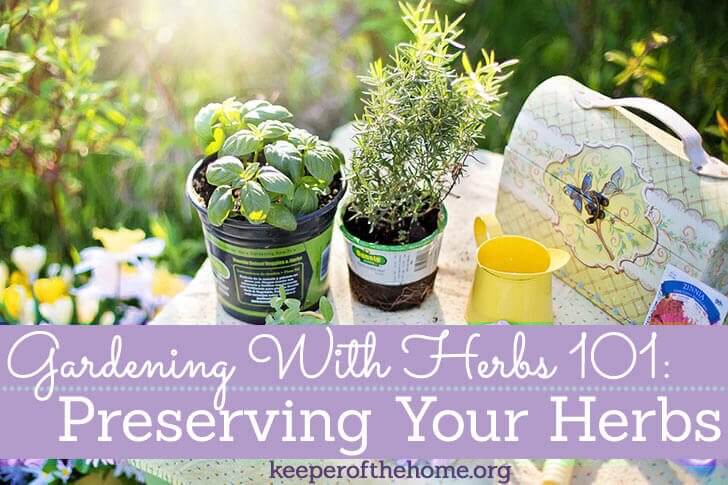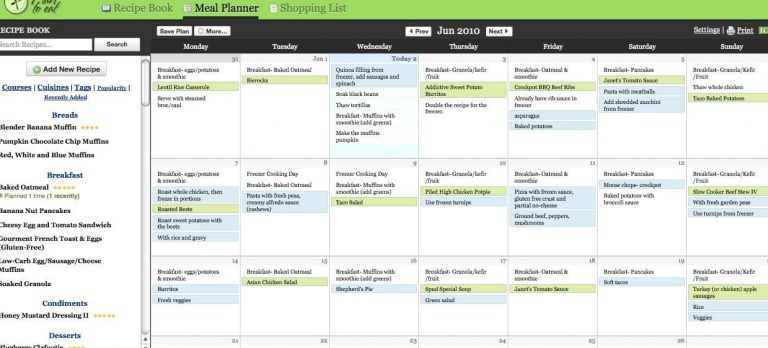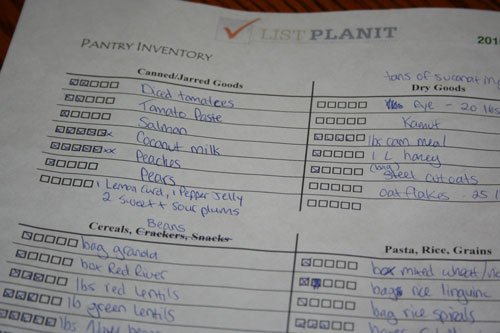Gardening with Herbs 101: Preserving Your Herbs

Written by Meg Dickey, Contributing Writer
Last time we talked about how to harvest your herbs – now that you’ve harvested them, what are you going to do with them?
Here are my favorite ways to preserve herbs for out-of-season use:
Freezing
This method best preserves flavor. Rinse the herbs and chop coarsely. Place about 1-2 teaspoons in each compartment in an ice cube tray. Cover with chicken stock, olive oil, or plain water and freeze. Transfer frozen cubes to Ziplock bags for longer storage. You can also spread herbs on a cookie sheet loosely and let freeze, transferring to Ziplock bags. Thawed herbs work wonderfully for cooking!
Air Drying
Remove dead or damaged foliage. Rinse only if necessary and let dry on a towel or spin in a salad spinner to remove all moisture. Make small bunches, securing the stems with twine or twist ties and hang in a warm, dry shaded place, allowing for good air circulation. Or, spread herbs on old window screens elevated from the ground. Stir often to ensure even drying. When leaves are crumbly dry, separate from the stems without crushing. Store in glass (or plastic) containers in a cool, dry place away from sunlight, moisture, and heat.
Drying with Heat
This is the quickest option for drying, especially for those who live in high humidity areas. It does tend to lessen the flavor and color of herbs, however, so keep that in mind. A food dehydrator is always a great option, even more so if you can turn the heat down very low, to retain better flavor and color. An oven will also work, although I generally only use this for roots, since it goes so quickly with the higher temperatures. Spread the herbs on a cookie sheet, and use the lowest possibly setting, even the heat from a pilot light will work well.

My other favorite methods for preserving herbs involve a little more – but I think they’re the BEST way to save many herbs for tasty uses!
Herbal Vinegars
This is the first way I actually learned to preserve herbs! Fill a tall jar about halfway with freshly cut herbs. Cover completely with vinegar. Let sit in a sunny windowsill for 3-4 weeks. Strain out herbs, and rebottle in a pretty bottle if you’d like. Will keep indefinitely in a cool cupboard. [This is one of my most popular herbal vinegars… great for this time of year!]
You can use any kind of vinegar you’d like, although I highly recommend you avoid white vinegar, even the organic kind, if you’re planning to ingest it. I use white vinegar for my cleaning, so I’ll often infuse a gallon or so with herbs to help scent or disinfect an area (rosemary, pine, and lavender are a few of my favorites).
Use your culinary instinct when it comes to choosing which herbs and vinegars to use – tarragon is wonderful in white wine or raw apple cider vinegar. Rosemary can withstand the robust flavor of basalmic or red wine vinegars. I love to use chamomile in champagne vinegar – so light and tasty! These can provide you with awesome flavors to use in dressings, condiments, and even as medicines.

Herbal Honey
I adore flavored honey. It’s nearly an obsession. And as soon as I realized the herbal honey I made at home tasted better, was cheaper, and I could choose what flavors I wanted, I was hooked. 🙂 You can add fresh herbs directly to honey, but I recommend using dried herbs, just to prevent any chance of mildew or unwanted fermentation (I had a rather enlightening experience with fresh ginger honey! Nothing like a “pop” when you open the jar!).
Add about 1/4 cup of dried herbs to 1 cup of slightly warmed honey (you can do this by warming in the oven, on a sunny windowsill, or on the stovetop, as I did in the video). Stir to combine. Let sit in a warm area for 2 weeks. You can strain out the herbs, or leave them – whichever you’d prefer.
Use anywhere you’d use honey – our family loved apple cinnamon rolls last winter drizzled with some of the cinnamon honey I had made. Delicious! You can also use herbal honey as a medicine, which was something else our family tried last year. I added garlic and sage directly to the honey, and let sit for 2 weeks. We had a wonderful, healing medicine that soothed throats and calmed coughs for our kids – and it wasn’t a hassle to have them take it!
Herbal Salts & Sugars
This is a great way to preserve highly scented herbs such as lavender or lemon balm. Slip a few fresh sprigs into a jar of salt or sugar, and let sit covered tightly for several weeks. I use the herbal salts (usually with eucalyptus leaves or chamomile) for bathtimes… it makes a lovely relaxing experience.
Herbal sugars are wonderful for baking – I enjoy using the lavender sugar when I’m making cakes or cupcakes. I also used the lemongrass sugar when I was making frosting for a cake. It turned out to have a delicate lemon taste, which everyone loved. I’m definitely going to be doing that again this year!






Thanks for these two posts, Meg! We didn’t attempt herbs this year because last year we had a horrible time with them! I am bookmarking these posts for the future! It would be SO nice to just grow our own!
Thank you, and oh so timely! I know what i am doing next week.
Oh, I like the idea of freezing herbs in ice cube trays with oil!
I have a silly question about basil that I can’t seem to find the answer to. Will basil survive a freeze, or is it an annual that dies in the winter and I’ll have to get a new one next spring? I’ve heard you can grow herbs indoors, so can I just bring it inside when it’s too cold? I kept it outside all summer, but it’s pretty sad looking. Next year should I keep it indoors during triple digit heat? Thanks for any tips!
@lyss, That’s not a silly question at all. 🙂 I usually cover our basil plants in the winter, esp. if there’s a frost warning. However, we live in a mild winter climate, so most of our plants don’t have a hard time. I would definitely bring it in for the winter if your temperatures are consistently low.
My basil plants last for 2-3 years, depending on the type (the darker colored ones seem to be more hardy). As for summer’s heat, I doubt bringing it in would be necessary, but do keep it well watered and maybe tent it with shadecloth if it looked like it was getting sunburned (which is what I did with mine this year) – yellowing leaves, etc.
I love to dry my own herbs. I take the leaf off the stem and pace them in a brown paper bag. I shake the ba twice a day for a couple of weeks.